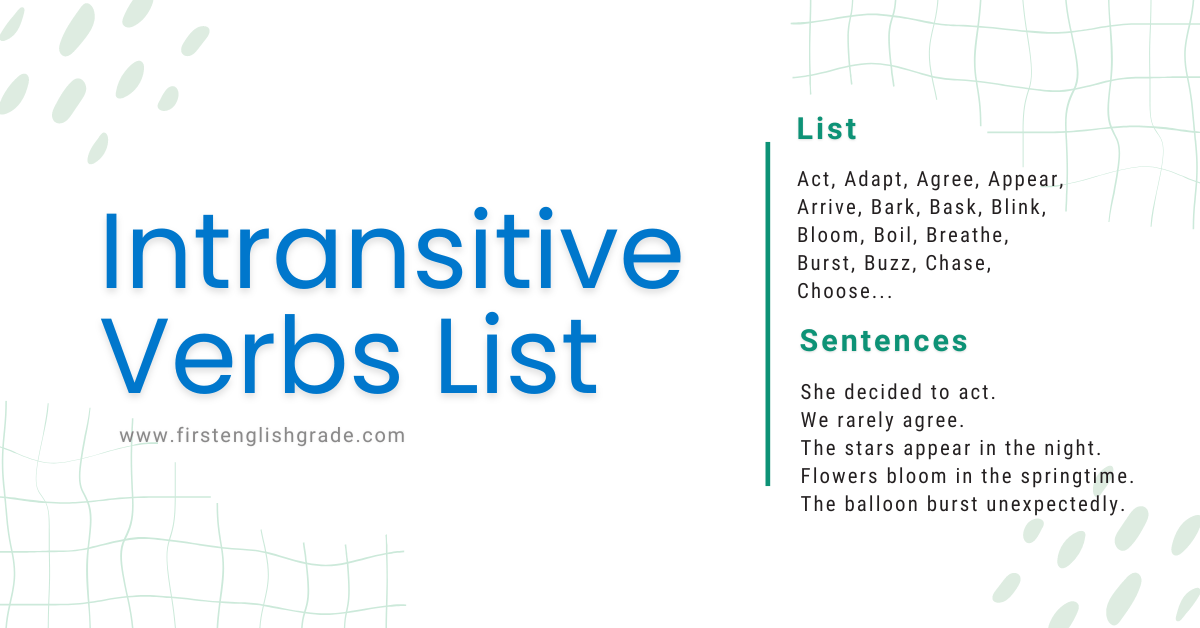Verbs are words that express actions or states of being and can be classified into two main types: transitive and intransitive verbs. In this article, you will find a list of 100 common intransitive verbs along with some example sentences to illustrate their usage.
Intransitive Verbs
Intransitive verbs are verbs that do not take a direct object, meaning that the action of the verb only involves the subject. For example, in the sentence “She smiled”, “smiled” is an intransitive verb because it does not require an object to complete its meaning.
In contrast, transitive verbs are verbs that do require a direct object, such as “She read the book”.
Intransitive Verbs List
| Intransitive Verbs List | |||
| Act | Adapt | Agree | Appear |
| Arrive | Bark | Bask | Blink |
| Bloom | Boil | Breathe | Burst |
| Buzz | Chase | Choose | Cough |
| Crawl | Cry | Dance | Depart |
| Descend | Die | Disappear | Dream |
| Drink | Drive | Eat | Elapse |
| Elope | Emerge | Escape | Exist |
| Explode | Fall | Fast | Fester |
| Float | Flourish | Fly | Freeze |
| Grow | Happen | Halt | Hesitate |
| Hide | Jump | Kneel | Laugh |
| Lead | Lean | Leap | Learn |
| Lie | Listen | March | Migrate |
| Move | Mourn | Panic | Pause |
| Play | Pray | Read | Relax |
| Remain | Respond | Rise | Roll |
| Run | Sail | Scream | Shake |
| Shout | Shrink | Sing | Sit |
| Sleep | Slide | Slip | Smile |
| Snore | Sneeze | Soak | Spin |
| Stand | Stay | Stop | Swim |
| Talk | Think | Travel | Vanish |
| Wait | Walk | Wander | Wave |
| Whistle | Work | Yawn | Yell |
Intransitive Verbs List: 100 Intransitive Verbs with Example Sentences
Let’s explore these 100 intransitive verbs with example sentences to understand how to use them correctly.
- Act: She decided to act.
- Adapt: Plants adapt to changes in their environment.
- Agree: We rarely agree.
- Appear: The stars appear in the night sky.
- Arrive: The train is scheduled to arrive at 3 PM.
- Bark: The dog likes to bark at passing cars.
- Bask: The cat loves to bask in the sun, finding a warm spot by the window.
- Blink: I couldn’t help but blink in the bright sunlight.
- Bloom: Flowers bloom in the springtime.
- Boil: Water will boil at 100 degrees Celsius.
- Breathe: We all need to breathe to survive.
- Burst: The balloon burst unexpectedly.
- Buzz: The bees continued to buzz around the blooming flowers.
- Chase: The children love to chase in the garden.
- Choose: It’s challenging to choose.
- Cough: He couldn’t stop coughing during the meeting.
- Crawl: The baby is learning to crawl.
- Cry: Sometimes, it’s okay to cry when you’re sad.
- Dance: They decided to dance under the stars.
- Depart: The train is about to depart; please board quickly.
- Descend: The eagle descended from the sky, swooping down to catch its prey.
- Die: Plants die without water and sunlight.
- Disappear: The magician made the rabbit disappear.
- Dream: I often dream of traveling to far-off places.
- Drink: Birds drink water from the birdbath.
- Drive: She learned to drive at the age of 16.
- Eat: Cats eat small meals throughout the day.
- Elapse: Time seemed to elapse quickly as they enjoyed each other’s company.
- Elope: The young couple decided to elope and get married in a small, intimate ceremony.
- Emerge: The sun will emerge from behind the clouds.
- Escape: The prisoner attempted to escape from the jail.
- Exist: Many rare species exist in the rainforest.
- Explode: Fireworks explode in the night sky on New Year’s Eve.
- Fall: Leaves fall from the trees in autumn.
- Fast: The cheetah can run very fast.
- Fester: If left untreated, a small wound can fester and become infected.
- Float: Boats float on the surface of the water.
- Flourish: With proper care, the neglected garden began to flourish with vibrant flowers.
- Fly: Birds fly south for the winter.
- Freeze: Water will freeze at low temperatures.
- Grow: Plants need sunlight to grow.
- Happen: Accidents can happen unexpectedly.
- Halt: The train came to a sudden halt as there was an obstruction on the tracks.
- Hesitate: Don’t hesitate to ask questions if you’re unsure.
- Hide: The cat likes to hide behind the curtains.
- Jump: Frogs can jump long distances.
- Kneel: The knight had to kneel before the king.
- Laugh: We all love to laugh at funny jokes.
- Lead: The path will lead you to the top of the hill.
- Lean: The tower of Pisa leans to one side.
- Leap: The rabbit leaped over the fence.
- Learn: Children learn by observing and experiencing.
- Lie: The cat likes to lie in the sun.
- Listen: Close your eyes and listen to the sounds of nature.
- March: The soldiers marched in perfect formation.
- Migrate: Birds migrate thousands of miles to find warmer climates during the winter.
- Move: The wind can move the branches of the trees.
- Mourn: People mourn the loss of loved ones.
- Panic: Don’t panic in emergencies; stay calm.
- Pause: She decided to pause and reflect on her decision.
- Play: Children love to play in the park.
- Pray: People often pray in times of need.
- Read: The child learned to read at an early age.
- Relax: It’s important to relax after a long day of work.
- Remain: The old castle remains standing after centuries.
- Respond: He will respond to your email as soon as possible.
- Rise: The sun will rise in the east.
- Roll: The ball will roll down the hill.
- Run: Horses can run at incredible speeds.
- Sail: Sailboats sail gracefully on the open sea.
- Scream: The crowd began to scream with excitement.
- Shake: The earthquake caused the ground to shake.
- Shout: It’s not polite to shout in public places.
- Shrink: Clothes may shrink if washed in hot water.
- Sing: Birds sing beautifully in the morning.
- Sit: Please sit down and make yourself comfortable.
- Sleep: Babies sleep a lot during the first few months.
- Slide: Children love to slide down the playground slide.
- Slip: Be careful not to slip on the wet floor.
- Smile: A genuine smile can brighten someone’s day.
- Snore: Some people snore loudly while sleeping.
- Sneeze: She couldn’t help but sneeze due to the dust.
- Soak: Let the dishes soak in soapy water before washing.
- Spin: The wheel began to spin rapidly.
- Stand: The statue has been standing in the park for years.
- Stay: We decided to stay at the beach for another day.
- Stop: The car will stop at the traffic light.
- Swim: Fish swim effortlessly in the water.
- Talk: Friends like to talk for hours on the phone.
- Think: Take a moment to think before making a decision.
- Travel: People love to travel to explore new places.
- Vanish: The magician made the coin vanish from his hand.
- Wait: We had to wait patiently for the bus to arrive.
- Walk: The elderly couple likes to walk in the park every morning.
- Wander: Tourists often wander through the city streets.
- Wave: The child waved goodbye to his friends.
- Whistle: He liked to whistle while he worked.
- Work: Bees work hard to gather nectar for honey.
- Yawn: The tired cat let out a big yawn.
- Yell: It’s not necessary to yell to get someone’s attention.




